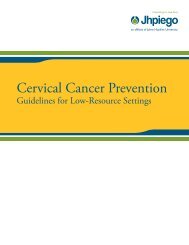Manual for Male Circumcision under Local Anaesthesia
Manual for Male Circumcision under Local Anaesthesia
Manual for Male Circumcision under Local Anaesthesia
You also want an ePaper? Increase the reach of your titles
YUMPU automatically turns print PDFs into web optimized ePapers that Google loves.
<strong>Male</strong> circumcision <strong>under</strong> local anaesthesia<br />
Version 3.1 (Dec09)<br />
Chapter 7<br />
Postoperative care and management of complications<br />
Summary<br />
• Possible complications of male circumcision include excessive<br />
bleeding, <strong>for</strong>mation of haematoma, infection, an unsatisfactory<br />
cosmetic effect, lacerations of the penile or scrotal skin, and injury<br />
to the glans.<br />
• Certain complications can be managed in the clinic. For others, the<br />
patient may need to be referred to a higher level of care.<br />
• Complications of circumcision can be avoided by ensuring asepsis<br />
during the procedure, per<strong>for</strong>ming careful and accurate excision of<br />
the inner and outer preputial layers, ensuring adequate<br />
haemostasis, and paying attention to the cosmetic result.<br />
POSTOPERATIVE CARE<br />
Postoperative monitoring<br />
It is very important to monitor the client <strong>for</strong> at least 30 minutes after<br />
surgery, because it is during this period that the effects of surgical<br />
trauma and other complications become apparent. Nurses or other<br />
staff members can carry out the tasks related to postoperative<br />
recovery and discharge, but the surgeon is ultimately responsible <strong>for</strong><br />
the quality of post-circumcision care.<br />
The summary below assumes that the circumcision has been<br />
per<strong>for</strong>med in a clinic <strong>under</strong> local anaesthetic. If circumcision was<br />
per<strong>for</strong>med in a hospital <strong>under</strong> general anaesthetic, the normal hospital<br />
recovery room protocols should be followed. a<br />
• Receive the client from the theatre; review the client record.<br />
• Monitor the client’s vital signs: check blood pressure, breathing,<br />
and pulse twice, at 15-minute intervals.<br />
• Check the surgical dressing <strong>for</strong> oozing or bleeding.<br />
• Ask the patient if he has any pain.<br />
• Observe the general condition of the client.<br />
• Administer any drugs or treatment prescribed.<br />
• Provide bland carbohydrates (such as a biscuit) and liquids to<br />
raise blood sugar levels unless medically contraindicated.<br />
• Handle the client gently when moving him.<br />
• Make the client com<strong>for</strong>table, according to the climate.<br />
• Complete the client record <strong>for</strong>m.<br />
Postoperative care and management of complications Chapter 7-1
















